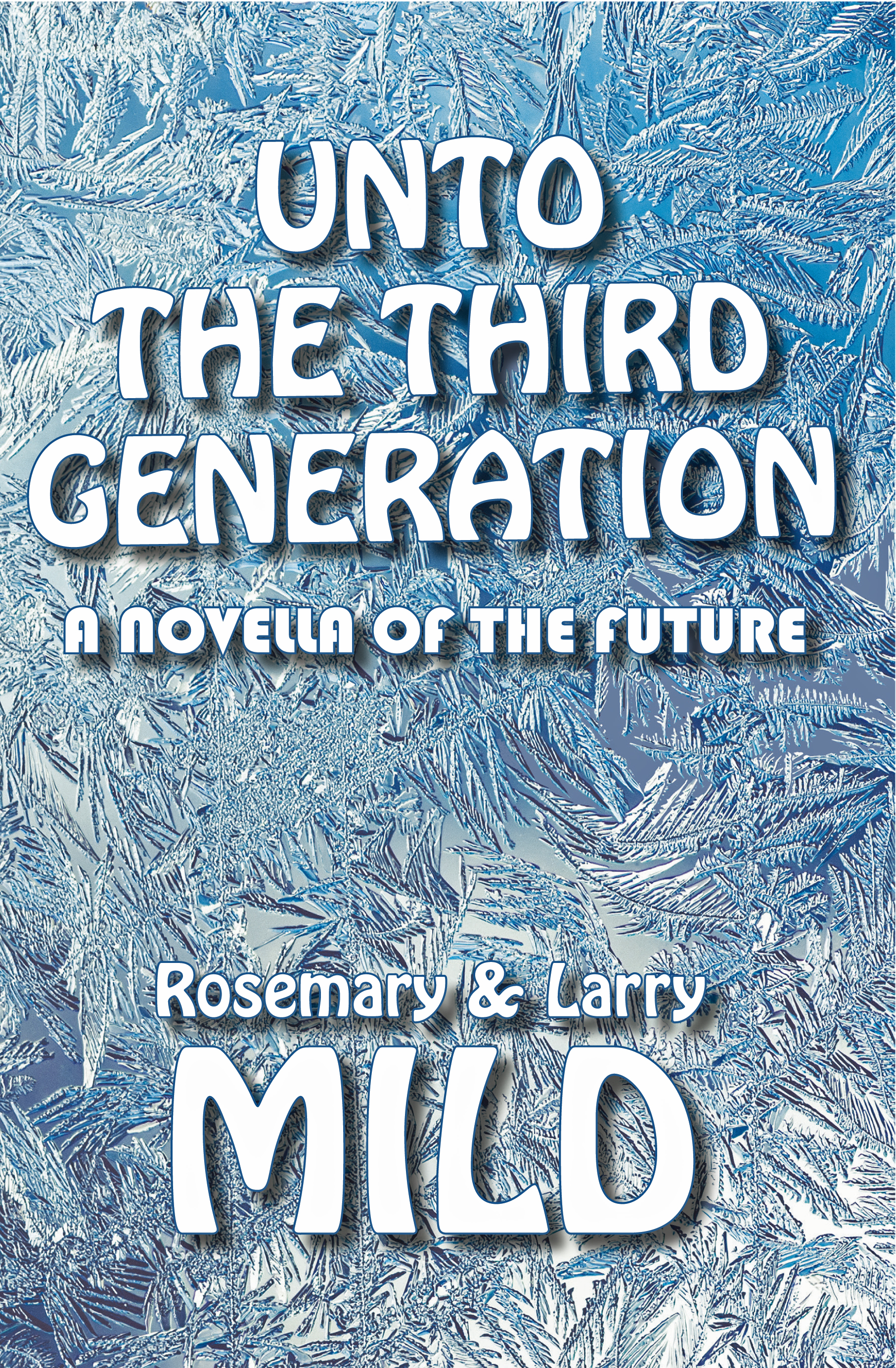 Magic Island Literary Works
Magic Island Literary Works A Thought Provoking Science Fiction Novella by Rosemary & Larry Mild.
| Home | Select Books From Spread | Authors | Contact Us | Author Interviews | Monthly Blog |
Rosemary and Larry's science-fiction tale will chill you to the core. Two young people, unaware of each other's existence, volunteer to become cryonauts—physically frozen in a life suspension experiment. Leonard Tall-Chief, a high-steel worker, and Francine Mapleton, a waitress, postpone their destinies for untold generations The year 2039 would be unremarkable except for two world-shaking events. The first marks a giant breakthrough for the well-being of all mankind. For once, no man, woman or child will ever go hungry again. Everyone will benefit from partaking of this discovery. But should they? The second event poses a threat to the human race itself—a disease that tortures, teases and ultimately kills. Will it spell the end of all human life? It will take three generations before these two events clash. And when they do, the very lives of Leonard and Francine will be at stake. |
 ISBN:978-0-9905472-2-8. Magic Island Literary Works |
To let Rosemary & know what you think of Unto the Third Generation, A Novella of the Future
E-mail us at: [email protected]
 |
 |
Buy autographed trade paperbacks at author's discount price: $9.95 + $5.85 shipping. E-mail us at: [email protected] |
| Enjoy a sample chapter of Unto the Third Generation, A Novella of the Future | |
Chapter 1
The Remarkable Year
The prime number year 2039 would have been unremarkable except for two significant events. The first event marked a giant breakthrough for the well-being of all mankind. The second posed a potential threat to the continued existence of all mankind. It would be the beginning of the third generation before the impact of these two events clashed.
* * * *
Today nearly a thousand dignitaries from all over the world have come to Italy to celebrate their joint achievement: the development of a new synthetic food process. The scientist most responsible for this world-shaking event is Umberto Valeriani, a native Neapolitan. He coordinated the process several years earlier in Palermo, Italy. Just a week ago today, Synthomanna was approved for worldwide distribution.
At the head table in the vast convention hall in central Rome, Umberto stood and grandly raised his wine glass. "I drink to the end of hunger on this planet. Salute!" Glasses clinked like chimes. A wave of toasts in many languages reverberated throughout the assemblage.
Umberto, a short, stocky man with a trim brown beard, had successfully combined the efforts of three brilliant scientists. He set his glass down and continued. "The esteemed colleague on my right, Edvard X. Holgren, has applied a series of new catalysts and processing techniques to certain fibrous pellets that can imitate the consistency and appearance of almost any food currently known to man. Think of it: the crispness of a cracker, the soft texture of a pudding, the tender chew of a filet mignon, or the melt-in-your mouth mashed potato. Thanks to him, these fiber pellets are easily and economically processed from a singular variety of tubers now growing all over the world. These particular tubers require little water and minimal chemical additives, and the resulting pellet is extremely lightweight to ship. Edvard has been working on this idea for twelve years. This great humanitarian has spent a good deal of his personal time and money trying to get his so-called ‘dry mannaâ’ tubers to grow nearly everywhere. I give you Edvard X. Holgren of Stockholm, Sweden."
Edvard pushed his chair back and stood as the sound of applause rose to an uncanny roar. "Thank you, thank you. Being able to mimic a desired consistency and appearance represents only a portion of the collective achievement honored here today. After all, what is food without flavor? My good friend Vassally Krackob, hearing of my work, was eager to join forces with me. He had developed nineteen basic condiments which, if used in the correct combinations and amounts, could just about duplicate the flavor of any foodstuff in the world larder. His condiments are processed easily and economically from plentiful mineral and plant sources.
"The key to Dr. Krackob's success is an agent used to lock in the desired flavor. It prevents anyone from flavor-tampering afterwards. This is not the first time that he has achieved world prominence. In 2024 he developed a harmless flavor only a desperately hungry person would and could eat. That locked-in flavoring additive was used to keep hunger relief supplies from finding their way into the black markets of the Third World nations. The locking agent ensured that the supplies were of value only to the starving and not to local opportunists. I introduce Vassally Krackob of Moscow, Russia."
Dr. Vassally took the microphone. "Thank you very much. But what of food value? Shouldn’t the meals we eat contain the elements our bodies need and crave? Dr. Sarah Bet Moshez has found an inexpensive way to add nutrients and pleasing taste to edibles lacking either one. Her process simulates a real meal. She is an Israeli scientist, a nutritionist working with the undernourished in a nearby Arab community. My colleague Umberto sought her out. Sarah was so enthusiastic about his project, nearly paralleling her own, that she immediately joined in. Working closely with Umberto, those two found a way to infuse essential vitamins and nutrients into the flavorful, substantial, and satisfying synthetic food forms developed by the rest of us. The trick here was to infuse without disturbing the molecular structure or flavor. I give you the lady who accomplished that goal in five short months, Dr. Sarah Bet Moshez."
This time the applause and glass-clinking included a few brazen wolf whistles at the dark-skinned, dark-haired beauty who now stood before them at the head table. "We thank you. The four of us collaborated on creating the first ideal synthetic food. We call it Synthomanna, our trademark legally registered with the European Union. Of course, Synthomanna must be marketed as synthetic. For the first time in history, with special additives, man can effectively control weight, calories, flavor, consistency and bulk."
In a sobered voice, Sarah continued. "To be sure, there will be a great economic impact on the current food industry. Much land use and industrial muscle will be directed elsewhere, as needed. There will be some fortunes lost and some gained. The same is true with jobs. As always, the skeptics will have to be won over and the diehards will fall by the wayside. We predict that within five years Synthomanna will be on everyone's table. But most important, it will be available in famine-ravaged countries. We expect much anger and protesting, but this time the world's malnourished and starving will come first.†Sarah raised her wine glass and shouted in Hebrew, "L'chaim, To life."
A young American scientist deep in the audience sprang out of his seat and asked, "With all due respect, aren't you rushing things a bit?" He gazed slowly around the great hall, his eyes deliberately locking on those of many individuals. "My distinguished colleagues, we haven't heard a word on the results of human trials. Have there been any? That is, any on the long-term effects of synthetic foods? Your revolutionary process goes well beyond genetically modified foods."
It would be years before the answers to those questions were learned.
* * * *
The second significant event of 2039 was the outbreak of a previously unknown and deadly disease. The earliest cases appeared in Florence, Italy (Firenze to the locals). When one physician there compared the fiery fevers to those of influenza, another physician ironically called it Infirenza. The name stuck and was thereafter used worldwide. But it was not like any strain of flu known previously. Already, Infirenza was spreading slowly across Europe in small geographic gulps with no identifiable carrier agents.
In the United States, Government officials noted this threat to an entire continent and designated a federal health agency to take over. The Institute for Prevention and Control of Infectious Diseases in Chicago, Illinois, began tracking Infirenza and trying to learn more about it. Calvin Meechum, MD, was put in charge and given an office and adjoining conference room on the fourth floor rear of the East Building. Calvin answered to the chief of the Institute. There was no way to know when or even if Infirenza would hit the United States, but they wanted to be prepared. Scientists assumed that, sooner or later, the virus would invade the U.S. via American travelers returning home from Europe and/or Europeans already infected who were vacationing or on business in the U.S.
Taking his seat at the head of the conference table, Calvin greeted his team of distinguished physicians and Ph.D. scientists. Although a slight man with rounded shoulders and seemingly mild manner, his keen gray eyes and no-nonsense approach commanded respect. "I'm new at this Infirenza thing, so how about you bring me up to date," said Calvin. "Sharon, what are the symptoms?"
Dr. Sharon O'Rourke looked older than her thirty-eight years. Researching the epidemic had already threaded her auburn hair with thick streaks of gray. She pulled a file from her briefcase and passed it to Calvin. "Essentially," she said, "the primary symptoms of this emerging disease are the fevers progressing from very low level to extremely high over time."
"How high and how much time?" asked Calvin.
"At least 106 degrees has been measured; beyond that, an agonizing death. Secondary symptoms caused by the Infirenza fever are agonizing headaches, as well as significant body fatigue and loss of sleep. The time span of the disease? A matter of months or sooner, depending on the initial health of the patient."
"No survivors?"
"None that we've heard of."
"How is Infirenza diagnosed?" asked Calvin. "How would it differ from, say, the flu before it's too late to treat?"
Sharon shook her head. "That's just it. The early stages are no different. There's almost no way to tell before it's too late."
Dr. Meecham wrote a few notes on a lined pad. When he raised his head he asked, "Then at what point is the diagnosis confirmed?"
Sharon slid a second page across the table to him. "We've collected some data on this—not nearly enough, but the best available so far. The one linking factor is that the fevers are cyclical in nature. Initial cycles are less intense, even moderate in some cases, leading doctors to think they're dealing with simple flu. Then the fevers attack in ever-increasing torrents, often deceptively lapsing into shrinking, cooler periods that vary for each patient. Painful deaths occur when the fevers peak beyond human tolerance. Most patients have died in the first few months. Others died shortly after. But many live normal, otherwise healthy, lives during the cool phase. They appear to be cured. Unfortunately, this phase never lasts. From the data we've been able to obtain, no one has ever escaped Infirenza's grip."
"What kind of periods are we talking about here?" Calvin's fingers fidgeted with his pen.
"Onset cycles vary with fever periods lasting from four to six days, followed by no-fever relief periods without symptoms, also lasting four to six days. The fevers increase in intensity in succeeding cycles for months until the unbearable terminal cycle. The intensities in that terminal cycle can't be measured beyond the 106 degrees maximum when death occurs. Terminal cycle periods vary from two to four days."
Calvin challenged her. "You used the words ‘almost no way to diagnose early.’ What did you mean by almost?"
"It has to do with treatment. None of the fever-reducing techniques or drugs seem to mitigate a patient's fever," replied Sharon.
"So we're stuck with an emerging fatal disease that we can’t treat and are having trouble diagnosing," Calvin said flatly. "Have we found a cause for this fever?"
"It has to be infectious somehow," admitted Sharon. "But even with all the brain scans and autopsies, we're still in the dark. There's no sign of accompanying unidentified viral or bacterial activity. We're still looking."
"Our team has performed all kinds of tests without success," Dr. Samuel Unser broke in. "We tried injecting contaminated body fluids into laboratory mice without luck. Exchanging ambient air between patient and mice disproved any of the suspect airborne paths." Dr. Unser hesitated before delivering another perplexing report. "Only three human trials have been performed. Three Italian prisoners, seeking relief from their life sentences, offered to be guinea pigs, if you'll excuse the expression, in clinical trials. They risked their lives to be exposed in similar tests. Oddly enough, none contracted the disease, and all three were rewarded with some finitely lower prison term."
Calvin scowled. "Nothing helpful there." He turned to the final member of his team, Harvey Adams, the scientist tracking the origin of the disease. "Harvey, have we identified patient zero yet and his or her location?"
"Yes, sir! Vitorio Deluca. He died twenty-two months ago in Florence, Italy. That's how Infirenza got its name. You know, the Florence-Firenze thing."
"Yes," retorted Calvin, frowning in impatience. "I understand that. Does the disease have any particular path of least resistance or a favorable path? Does it seek anything tangible?"
"No, sir," Sharon replied. "The path is one of its own convenience. It creeps ever so slowly--one or two square kilometers per month, completely devastating everyone in its path."
Calvin momentarily stared into space while he tried to think of anything worthy to add. He laid down his pen, his expression grim. "That's it. Stay with it and keep me informed."
As they all filed out, one thought plagued each of them: Are we facing a pandemic? A worldwide disease?
| Go to top of page | |